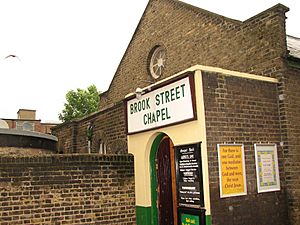Brook Street Chapel facts for kids
Quick facts for kids Brook Street Chapel |
|
|---|---|

Brook Street Chapel, Tottenham
|
|
| 51°35′35″N 0°04′09″W / 51.5931931°N 0.0690588°W | |
| Location | Brook Street, High Road, Tottenham, London N17 9JG |
| Country | United Kingdom |
| Denomination | Open Brethren |
| Website | [www.brookstreetchapel.co.uk] |
| History | |
| Founded | 1839 |
| Founder(s) | Robert and John Eliot Howard |
Brook Street Chapel is a church building located in Tottenham, North London. It was built as a meeting place for local Christians who were part of the Plymouth Brethren movement.
Contents
History of Brook Street Chapel
How the Chapel Started
In 1838, a small group of about eight people, who had left the Quakers, began meeting at Mrs. Sands' house. This house was on Stoney South, which is now called Stoneleigh Road. Because the group grew, the Brook Street Meeting House was built and opened in 1839.
Two important people in this group were the chemist John Eliot Howard and his brother Robert. Their father, Luke Howard, who was a famous meteorologist (someone who studies weather), also helped pay for the building. He moved to Tottenham shortly after. Today, you can find special plaques in Tottenham that remember the Howards. There's a blue plaque for Luke at 7 Bruce Grove and a green plaque for John where his home used to be.
Growth and Community Work
As more people moved to Tottenham in the 1800s, the number of Christians meeting at the chapel also grew quickly. By 1842, there were about 88 members, and by 1851, around 140.
The church was very involved in helping local children. By the early 1900s, their Sunday School had about 600 children! Because of this, the original Meeting House, now known as Brook Street Chapel, was used only for children's activities. Other church meetings were held in different rooms across the High Road between 1880 and 1903.
The Chapel building was made bigger in 1939 and again in 1955. These additions included a schoolroom and a hall at the back for youth activities. Today, the building takes up the entire Brook Street. This happened after World War II bombing destroyed the houses further down the road.
The Tottenham Memorandum Explained
Inside the Chapel, you can see something called the Tottenham Memorandum. This document was created when the Plymouth Brethren movement split into two main groups: the Open Brethren and the Exclusive Brethren. The Memorandum shows that Brook Street Chapel chose to remain 'open'. This meant they welcomed any Christians who truly believed in Jesus Christ, as long as they could show their faith.
Notable People Connected to the Chapel
Many interesting people were part of or visited Brook Street Chapel. Besides the Howards, James Von Summer, who started the Echoes of Service magazine, was a member. Edmund Gosse, a famous writer, taught in the Sunday School.
Other well-known Christians who taught or visited include John Nelson Darby, Anthony Norris Groves, George Müller, and James Hudson Taylor. Even Thomas Barnardo, who founded children's homes, visited. Philip Gosse, a famous naturalist and Edmund's father, and his wife Emily Bowes were married at the chapel in 1848.
Location and Nickname
Where is the Chapel?
When Brook Street Chapel was built, Tottenham was a rich area outside of London. The chapel, like the Plough pub next to it, was built a bit back from Tottenham High Road.
The "Hidden Church"
Over time, new buildings were constructed in front of the chapel. These new buildings, which now include a Ladbrokes betting shop, partly hide the chapel's front from the High Road (which is now the A10). Because of this, the chapel earned the nickname "the hidden church."
The Chapel's Green Space
The land south of the chapel was once a burial ground. When it was no longer used for burials, the land was given to the London County Council. They promised to keep it as an open, public space forever. Today, this area is a children's playground and a paved space for everyone to enjoy.


